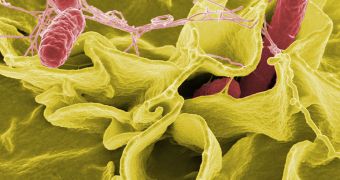Treating salmonella infections in poultry is rapidly becoming one of the most important methods of increasing food security. Working towards that end, a team of Canadian researchers was recently able to isolate a microorganism in the Arctic that may be of help.
Investigators at the University of Victoria, led by microbiologist Dr. Francis Nano, believe that bacteria collected from cold Arctic waters may hold the key to immunizing chickens against Salmonella enterica infections.
This bacteria causes millions of deaths annually in official statistics, which means that the actual numbers may be even higher. In Canada, around 10,000 people are infected by the pathogen yearly.
As such, salmonella is viewed as a critical public health concern. Scientists say that it represents the most common, food-borne disease in the world. In addition to being harmful in and of itself, the organism also favors the development of other conditions.
Using funds provided through the Genome BC Proof-of-Concept initiative, Nano and his team have been working on a way to use the Arctic bacteria in a new vaccine against S. enterica. Their approach (simple in theory, but difficult to apply in practice) appears to be working, PhysOrg reports.
The research resulted in the creation of a temperature-sensitive vaccine. What the chemical does is it replaces one of the genes in S. enterica with a gene from the Arctic bacteria. The switch renders the former unable to resist the temperatures in the bloodstream of warm-blooded animals.
The modified salmonella will then immediately die out, immunizing the host to future infections by the same strand. The team was able to demonstrate in its investigation that producing the vaccine would also be cost-effective.
This implies that it could be used by authorities, farmers and big companies alike. All those involved in raising animals would stand to benefit from this substance, as would national economies, experts say.
“Using Arctic genes, we can create bacterial pathogens that behave like vaccines, much like the many temperature-sensitive viruses that are used as vaccines. We can apply this same approach to develop new vaccines against many diseases of humans and animals,” Nano explains.
Vaccinations are becoming increasingly important in animals nowadays because overuse of antimicrobial drugs and antibiotics has given rise to a wide array of drug-resistant microorganisms, which cannot be killed by conventional means.

 14 DAY TRIAL //
14 DAY TRIAL //